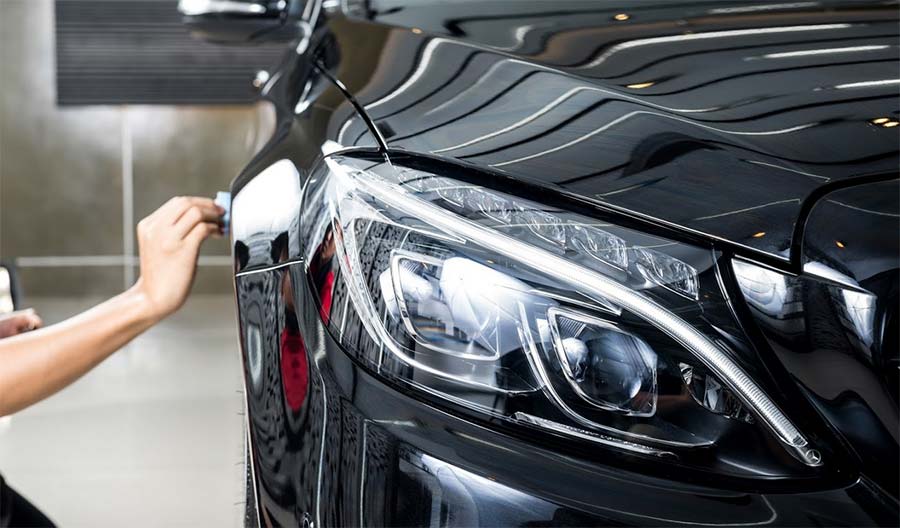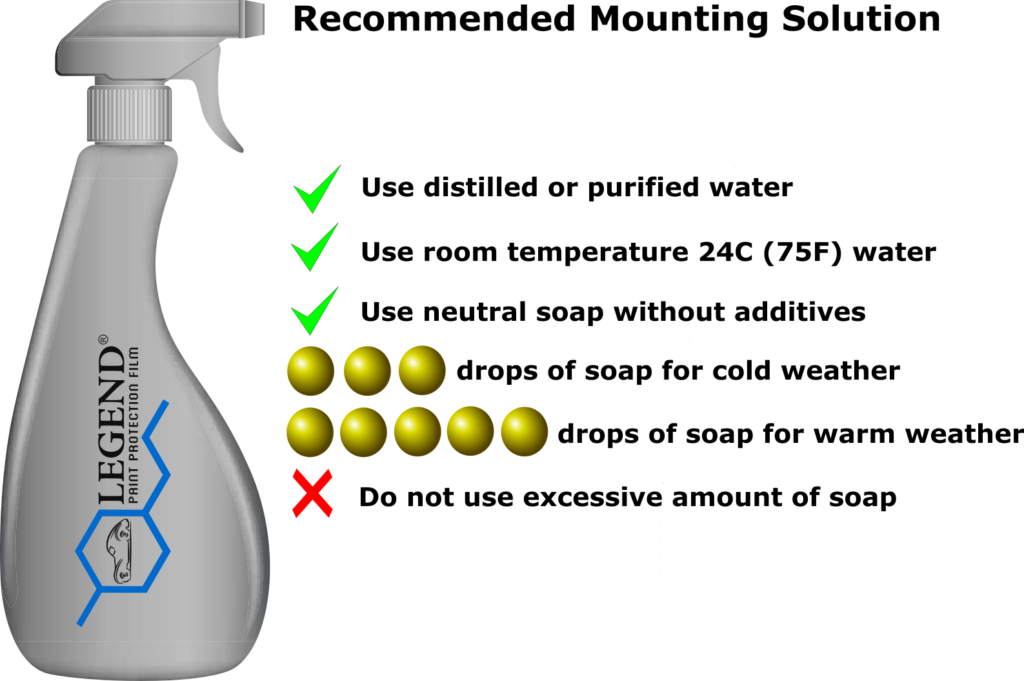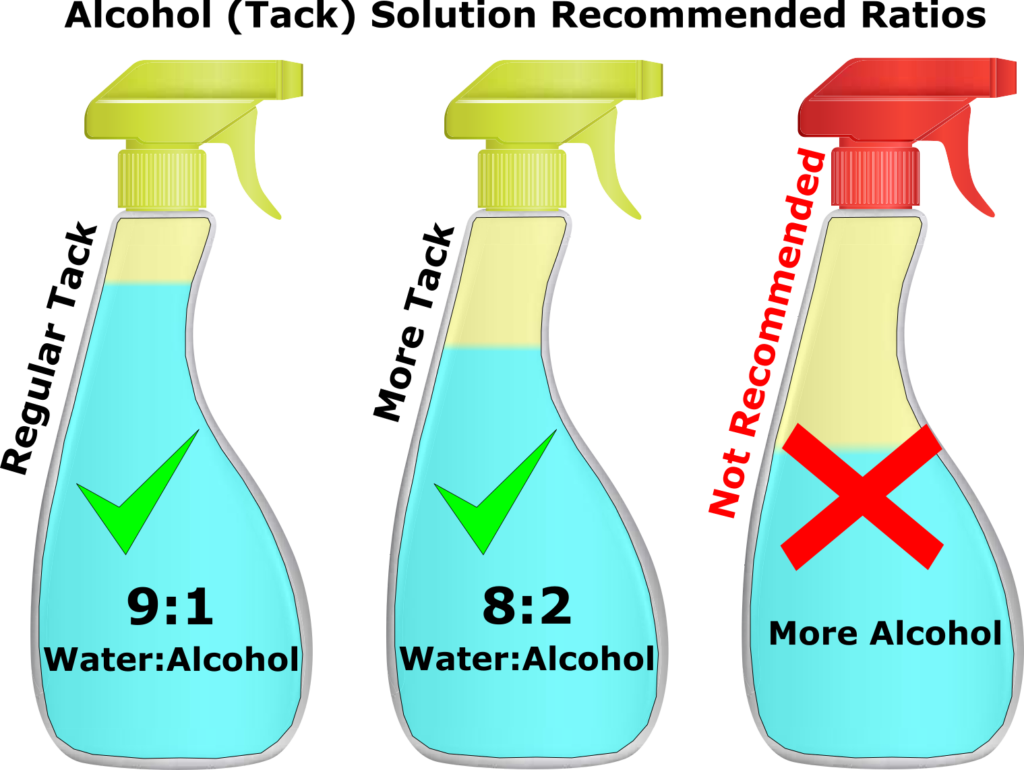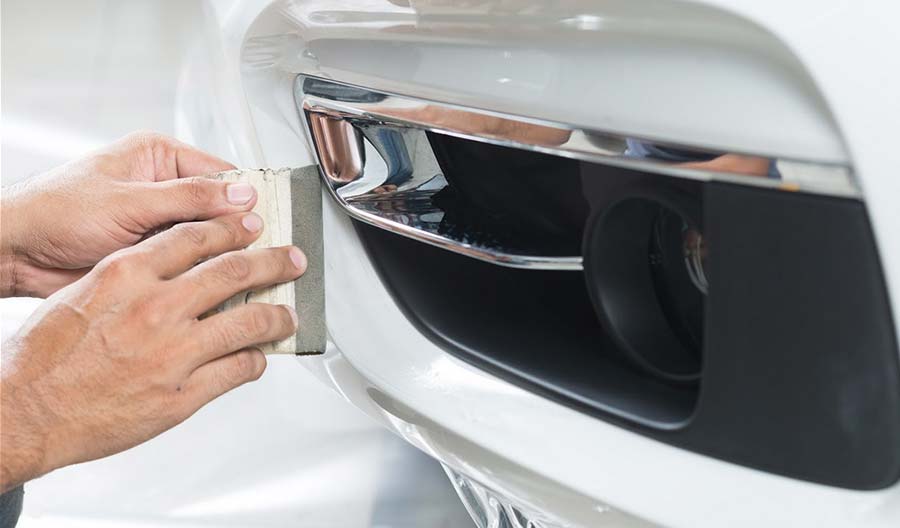LEGEND Installation and Care Instructions
Installation care instructions and references for LEGEND Paint Protection Film
LEGEND Paint Protection Film has industry leading properties. Please read this entire manual to ensure that the benefits of our PPF are optimized during the installation process. Share this information with car owners, as these care instructions will aid in giving the customer’s vehicle a long-lasting appearance and value.
1. Before Installation (Surface Preparation)
- It is important to thoroughly clean the surface of the vehicle to avoid contamination during installation. We recommend using a high pH detergent mixed with water for washing the car surface. This mixture tends to do a much better job at removing oil, dirt, grease, bugs, and road film compared to regular soap.
- Clean the area around the part of the car that will have the film installed. An example would be: if you plan on applying a strip of PPF on the hood of the car, first clean the entire hood, fender, and headlights.
- To avoid film contamination, i.e. dirt leaching out during the installation process, we recommend using a high-pressure washer and/or pressurized air. Wash/blow dirt from the seams and openings around the headlights, grilles, fog lights, etc. to ensure a clean base for the PPF installation.
- After the car is washed, use a cleaning clay bar/pad/mitt or auto scrub to thoroughly clean the surface before installing the PPF. Clay will remove the paintwork defects (metal dust, road debris, particulates, etc.) that were not removed during the previous cleaning processes.
- If additional degreasing of the car is needed, remove the oil deposits with isopropyl alcohol and wipe dry.
- Using pure isopropyl alcohol and lint-free wipes, wipe the edges of the area that the PPF will be applied to. This step will ensure that the edges are clean from all contamination and help create a stronger surface contact with the film.

2. Tools and Mounting Solutions
Tools
- Squeegee – for washing the vehicle
- Yellow Turbo Squeegee – for installation
- OLFA knife and blade (carbon steel or ceramic)
- 32-ounce spray bottle (or larger)
- Heat gun (optional)
Mounting Solutions

- For best results, use distilled or purified water for the installation. Tap water can contain excessive amounts of dissolved minerals (Iron, Calcium) that will be detrimental to the installation or finished film aesthetics. Best to use water at room temperature 24°C (75°F).
- Use Johnson Baby Shampoo, or any other neutral soap without additives such as moisturizers, as additives can leave hazy traces under the film.
- Soap solution for cold weather. If air (car surface) temperature is 15°-23°C (60°-74°F), add 2-3 drops (<0.5ml) of soap per 32-ounce spray bottle.
- Soap solution for warm weather. If air (car surface) temperature is 24°-32°C (75°-90°F) use 4-5 drops (<1ml) of soap per 32-ounce spray bottle.
- There are other paint protection films on the market that may require significantly higher amounts of soap during installation. However, using more than the recommended amount of soap for the LEGEND product will cause it to slide excessively and compromise the adhesion. Please use our recommended soap levels for the best installation results.
Alcohol (Tack) solution

- Use isopropyl alcohol that can be purchased in any pharmacy/grocery store. It is typically available in 70% or 90% grades (both are acceptable). Make sure to dilute the alcohol with water according to the instructions below. Do not apply the alcohol to the adhesive in pure form as the adhesive may turn hazy!
- Recommended proportion for tack solution: 9 parts of water to 1 part of alcohol. If more tack is desired, increase the alcohol concentration to 8 parts of water for 2 parts of alcohol. We do not recommend any higher alcohol concentrations.

3. Installation Environment
Paint protection film should be stored and installed within the 15°-32°C (60°-90°F) temperature range to ensure that the film is flexible and the adhesive retains its full tack. Installation should not be attempted under direct sunlight or in areas exposed to the outside air that may introduce contamination between the film and the car surface.
If the outside temperature is over 32°C (90°F)
- Let the car cool to the temperature of your installation booth
- Raise the hood and allow the under the hood area to cool before installation
- Do not install film under the direct sunlight
If the outside temperature is below 15°C (60°F)
- Ensure the car warms up inside your installation booth to at least 15°C (60°F). During winter month you can use infrared heaters to speed up this process.
- Use warm water for both mounting and alcohol (tack) solution. If the film slides too much, decrease the amount of soap.
- When installation is complete make sure that all of the edges adhered well. Use heat gun to warm up/dry the areas at the edges that could retain water. This ensures the film adheres well. Do not overheat the film! Apply the air stream from the heat gun to your hand for 2-3 seconds and if it is too hot to handle– then it will be too hot for the film as well.
If the outside temperature is below freezing 0°C (32F)
- Follow recommendations for below 15°C (60°F) above for the installation process.
- Warm up the film edges during the installation to ensure proper adhesion. Keep in mind that ‘warming the film’ does not mean ‘melting film to the car surface’. Do not overheat the film! Apply the air stream from the heat gun to your hand for 2-3 seconds and if it is too hot to handle– then it will be too hot for the film as well.
- A car with the film installed should not be moved outside for at least 12 hours after installation to ensure that water dries properly and the film anchors.
- If the outside temperature is below freezing it may be a good idea to keep the car under the infrared heaters overnight to ensure proper film drying/curing.

4. Installation
One of the main advantages of LEGEND paint protection film is the extreme ease of installation. LEGEND film does not need to be stretched excessively. Overstretched film will tend to pull back often resulting in lift off and fingers at the edges. Here are the general recommendations for common car areas:
Hood
- Spray soap and water solution generously under the film as you align it into position.
- Lock the film with tack solution on one side of the hood by squeegeeing water out towards the edge.
- Stretch the film towards the other side of the hood and lock it down by squeegeeing water out as well.
- Be careful not to overstretch the film to avoid formation of fingers.
- Remove the water from under the hood by squeegeeing up and down in overlapping strokes. Make sure not to move water towards the already tacked area as it may cause water bubble entrapment or adhesive deformation.
Bumper
- Align the film on the bumper. You can temporarily tack the corners to ensure that the film stays in place.
- Find the good alignment point in the center and tack it down using alcohol solution. Do not to stretch the film in the center.
- Next, align the film around grille and sensors going from the center towards the wheels using minimal stretching, especially around the sensors or cutouts. Remember, overstretching the film there will cause fingers to form
- Finally, lift the temporary tacked corners, stretch the film gently towards the wheel arches and then tack it down using the alcohol solution.

5. Installation Tricks
Fingerprints
- Keep your hands wet during the installation. Remember – dry fingers applied to dry adhesive WILL leave fingerprints. Reduce the risk of leaving the fingerprints during the installation by using gloves.
- If a fingerprint appears on the adhesive surface, apply soap solution to the affected area and gently rub the area until the print disappears.
Removing Dirt/Contamination from under the film
- If possible, flip the film so that the adhesive side is up, spray the adhesive layer with soap and water solution and then wipe the contamination from adhesive while wet.
- If it is not possible to flip the film adhesive side up – spray soap and water solution under the film and try to remove the contamination. Do not rub the adhesive layer too vigorously as it may leave the trace visible especially on dark cars.
- Do not use alcohol (tack) solution to lift the film when removing contaminations. Alcohol solution softens the adhesive and makes it sensitive to damage. Make sure to use soap and water solution for dirt removal.
Removing adhesive lines
- To reduce the possibility of forming an adhesive line lift the film without forming the straight edge on the adhesive. Instead, raise the film in a shape of the pocket while adding plenty of soap and water solution under the film. Use your squeegee to first move water towards the potential adhesive line and then squeegee the water from under the film.
- If you must lift the film for a significant amount of time lift it until you reach a shape change on the hood. The adhesive line will be much less visible in such space.
Removing mars
- Always make sure to keep the top of the film wet with soap and water solution to prevent mars as you are squeegeeing the water. If you mar the film surface let it sit for 20 minutes and then use isopropyl alcohol and microfiber cloth to remove the mar.
Water bubbles
- Always remove water by squeegeeing the film away from the area that used Alcohol (Tack) solution. Trying to remove water through adhered area may leave the water bubbles.
- Bubbles that are 4-5mm (1/8”-1/4”) may dry by themselves. However, the best solution is to remove all of the water from under the film. If you leave large bubbles under the film they, most likely, will turn into the air pockets upon drying.
- Water bubble can be removed either by lifting the film and re-squeegeeing it or, if the bubble is to far from the edge by using 1cc/1ml syringe.
How to wrap the edges
- Prepare enough film to wrap around the edge as you are cutting the film for each car area. You will need at least 1-1.5cm (0.5-0.75”) of film to wrap in order to create a good bond in those areas.
- Clean areas where the film will be wrapped to with pure alcohol using lint-free wipes. This is very important as the surfaces under the hood are exposed to oily contamination and must be thoroughly de-greased.
- You can use adhesion promoters or primers in those areas such as 3M’s Primer 94. Make sure not to use primer on the outside facing surface as the primer will most likely change the color over time.
How to prevent edges from lifting up
- It is very important to properly prepare the edges before installation. The edges are degreased with pure alcohol using lint-free wipes. After the surface is degreased with alcohol, wipe it dry to prevent damage to the adhesive.
- Make sure that the edges are laying on the flat surface of car body and do not overhang. For the templates that are not made for wrapping, the film edge should be at least 2mm (1/16”) away from where the body panel starts curving to the edge.
- Small film overhang could be adhered to the car body panel once the mounting solution dries up. However, this creates potential areas for dirt and water collection over time and may cause film detachment in the future.
- Even in warm climates wait for at least 1-2 hours for film to adhere and double check all of the edges before returning the car. This is especially important in colder/rainy weather. See recommendations above for the freezing temperatures.

6. Removing the film
- Remove the film by pulling at 45 degrees towards yourself
- Do not pull the film at over 90-degree angle and do not try to rip the film off the car surface as it may transfer some of the adhesive to the car paint.

7. Recommended Cleaning and Care
Cleaning
- Using a regular car wash is recommended after waiting a minimum of 3 days to allow film to fully cure to the car. During the winter months the waiting period may need to be longer.
- Regular hand washing car (if so desired) with soap and water is absolutely fine.
- We do not recommend using pressure washer or car washes that use handheld pressure washers. If such a car wash is used, inform wash employees that the car has paint protection film. To avoid lifting the paint protection film the distance from the pressure washer nozzle to the film surface should be at least 45cm (1.5ft)
- Waxing the glossy LEGEND Prime with non-abrasive car wax is recommended at minimum 2 times a year. Applying was to your LEGEND Prime will help retain its pristine glossy look. When waxing LEGEND Prime Matte use only the waxes recommended for matte surfaces.
- Ceramic coatings can be applied on top of LEGEND films.
Removing Bugs
- Insects can be removed from LEGEND paint protection surface using regular car shampoo and a sponge. Alternatively, bug and tar removing shampoos can be used. In difficult cases soaking the surface for 15-20 minutes with bug removing shampoo may be needed.
Recommended Care
- To remove dirt and excess wax that may collect at the edge of the film use isopropyl alcohol and a microfiber wipe to clean along the edges.
- To avoid film staining, clean the bird droppings, bugs and visible contaminates from the car on a regular basis.
- LEGEND paint protection film contains a unique topcoat protecting it from staining and discoloration. However, if cleaning and care instructions are ignored or if the film was exposed to extremely staining chemicals a slight discoloration may occur.
- To recover the original clear appearance, use mild abrasive wax/polishing compound to the surface until the stain is not visible. We do not recommend repeating the use of abrasive wax/polishing more often than once every two years as it will eventually remove the topcoat from the film. Only polish the vehicle with abrasive compounds when absolutely necessary.
 German
German Spanish
Spanish Hebrew
Hebrew